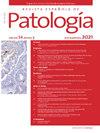Cytomorphological patterns in bronchoalveolar lavage in the diagnostic evaluation of pulmonary diseases
IF 0.5
Q4 Medicine
引用次数: 0
Abstract
Background
Bronchoalveolar lavage (BAL) cytology is a well-established diagnostic tool for respiratory tract lesions. The analysis of cellular patterns in BAL cytology provides useful information about infectious, inflammatory, and neoplastic lung diseases. This study aimed to analyze bronchoalveolar lavage fluid to investigate various cellular patterns in BAL cytology in different pulmonary diseases.
Material and methods
This retrospective study was conducted in the Department of Pathology and included BAL cytology samples from 182 patients between January 2022 and July 2023.
Results
Of the 182 cases, 116 (63.7%) were male and 66 (36.3%) were female. Thirty-seven (20%) cases showed a predominantly neutrophilic cellular pattern, while 61 (33.5%) showed a lymphocytic pattern. Two (1%) cases showed a mixed cellular pattern, including eosinophils. In 32 (17.5%) cases, patterns indicating specific aetiology were identified, the most common being AFB-positive granulomatous inflammation (4.3%), followed by fungal hyphae (1.6%). Malignant cells were seen in 15 (8.2%) cases, with the most common pattern being cells arranged in an acinar pattern, indicative of adenocarcinoma. A rare case of pulmonary alveolar proteinosis was diagnosed based on the presence of PAS-positive extracellular granular to globular material in cytology.
Conclusion
In the era of minimally invasive procedures, BAL cytology analysis stands out as a valuable tool for diagnosing various lung diseases. It aids in the diagnostic workup for many diseases, including those of tubercular, fungal, and neoplastic aetiology. Combining clinical details, radiological information, and BAL cytology can help provide a definitive diagnosis and avoid invasive procedures.
支气管肺泡灌洗细胞形态学对肺部疾病的诊断价值
支气管肺泡灌洗(BAL)细胞学是一种公认的呼吸道病变诊断工具。BAL细胞学中细胞模式的分析提供了关于感染性、炎症性和肿瘤性肺部疾病的有用信息。本研究旨在分析支气管肺泡灌洗液,探讨不同肺部疾病的BAL细胞学变化。材料和方法本回顾性研究在病理学系进行,包括2022年1月至2023年7月期间182名患者的BAL细胞学样本。结果182例患者中,男性116例(63.7%),女性66例(36.3%)。37例(20%)以中性粒细胞为主,61例(33.5%)以淋巴细胞为主。2例(1%)显示混合细胞模式,包括嗜酸性粒细胞。在32例(17.5%)病例中,确定了特定病因的模式,最常见的是afb阳性肉芽肿性炎症(4.3%),其次是真菌菌丝(1.6%)。15例(8.2%)可见恶性细胞,最常见的是细胞呈腺泡状排列,提示腺癌。一个罕见的肺泡蛋白沉积症的诊断是基于在细胞学上pas阳性的细胞外颗粒到球状物质的存在。结论在微创手术时代,BAL细胞学分析是诊断各种肺部疾病的重要工具。它有助于诊断工作的许多疾病,包括那些结核,真菌,和肿瘤病因。结合临床细节,放射学信息和BAL细胞学可以帮助提供明确的诊断并避免侵入性手术。
本文章由计算机程序翻译,如有差异,请以英文原文为准。
求助全文
约1分钟内获得全文
求助全文
来源期刊

Revista Espanola de Patologia
Medicine-Pathology and Forensic Medicine
CiteScore
0.90
自引率
0.00%
发文量
53
审稿时长
34 days
 求助内容:
求助内容: 应助结果提醒方式:
应助结果提醒方式:


